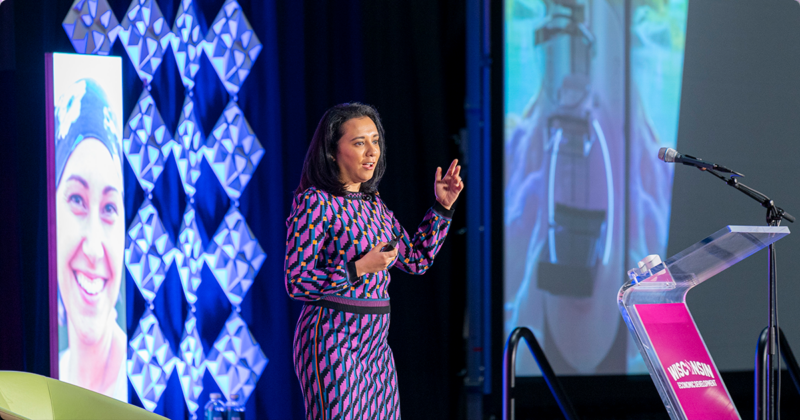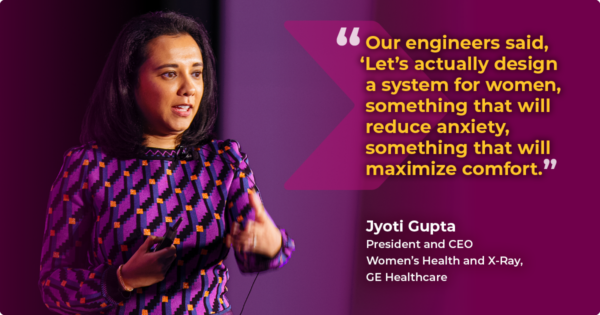
At the Wisconsin Economic Summit 2024 in La Crosse, Jyoti Gupta described GE Healthcare’s innovations in breast cancer screening.
Listening to women’s health care needs, especially in the realm of breast cancer screening and detection, led to engineering innovations at GE Healthcare.
Those innovations produce a better patient experience and remove the anxiety that can prevent some women from getting mammograms, said Jyoti Gupta, president and CEO of women’s health and X-ray at the Waukesha-based firm.
“Our goal was to bring in empathy and humanize the mammography experience,” Gupta told attendees at the Wisconsin Economic Summit in La Crosse Oct. 15.
Breast cancer screening is crucial, as one in eight women will have breast cancer sometime in their lifetimes. Still, the screening technology continues to evolve. One-fifth of cancers are missed, and half of women will be told they have breast cancer when they don’t, Gupta said.
Clinicians are challenged because cancer is more difficult to detect in women with dense breasts—who make up 40% of U.S. women, and account for 70% of cancer diagnoses. Beyond that, only half of women who are recommended to get mammograms actually receive those screenings.
“We try to understand why that is the case. It turns out it’s because of fear of discomfort, pain, anxiety,” Gupta said. “Our engineers said, ‘Let’s actually design a system for women, something that will reduce anxiety, something that will maximize comfort.”
The result was the Senographe Pristina™ system, which features heated plates that compress the breasts during the imaging process.

“Traditionally, it’s quite cold and it’s quite sharp and it can poke and hurt,” Gupta said. “What our team did was focus on making rounded corners, rounded edges and made the plates thicker and heated the plates.”
There are also handles on a conventional mammography machine that engineers redesigned. “When you hold them, women typically tense up because of the increase in anxiety. That makes it harder to get the right image the first time,” Gupta said.
So, engineers created circular arm rests, inspired by how a woman holds a baby.
“They may sound trivial now, but they make a really, really big difference for women,” Gupta said, adding that more than 90% of women tested on the machine said they were not anxious at all or were less anxious.
Breast compression is usually done by a technologist. But GE Healthcare engineers designed a handheld control that allows women, under the guidance of a technologist, to control the compression themselves.
“The technologist is typically afraid to hurt the patient. The woman knows herself, so she can compress more, which is really, really good because when you compress more, you separate your tissue more and you get a better image and you can see more cancer,” Gupta said.
GE Healthcare, with six sites across Wisconsin, also designed a “sensory seat” for patients. For example, it can project a rainforest scene with the sound of water and even smells from that setting. It also has waterfalls, park-like settings, and a beach scene.
“We learned that sensation, sensory stimulation, sound, sight, and even smell can help reduce the anxiety,” she said.
In addition to improving the mammography experience, GE Healthcare found a way to improve the imaging of dense breasts.
The firm worked on a technology called contrast-enhancing mammography that uses the same machine but introduces a contrast element that reduces the masking effect of breast tissue, enhancing diagnostic capabilities.
“We work in Wisconsin and across the world, across our sites and all our modalities, to bring the best solutions to really treat the entire care pathway,” she said.
